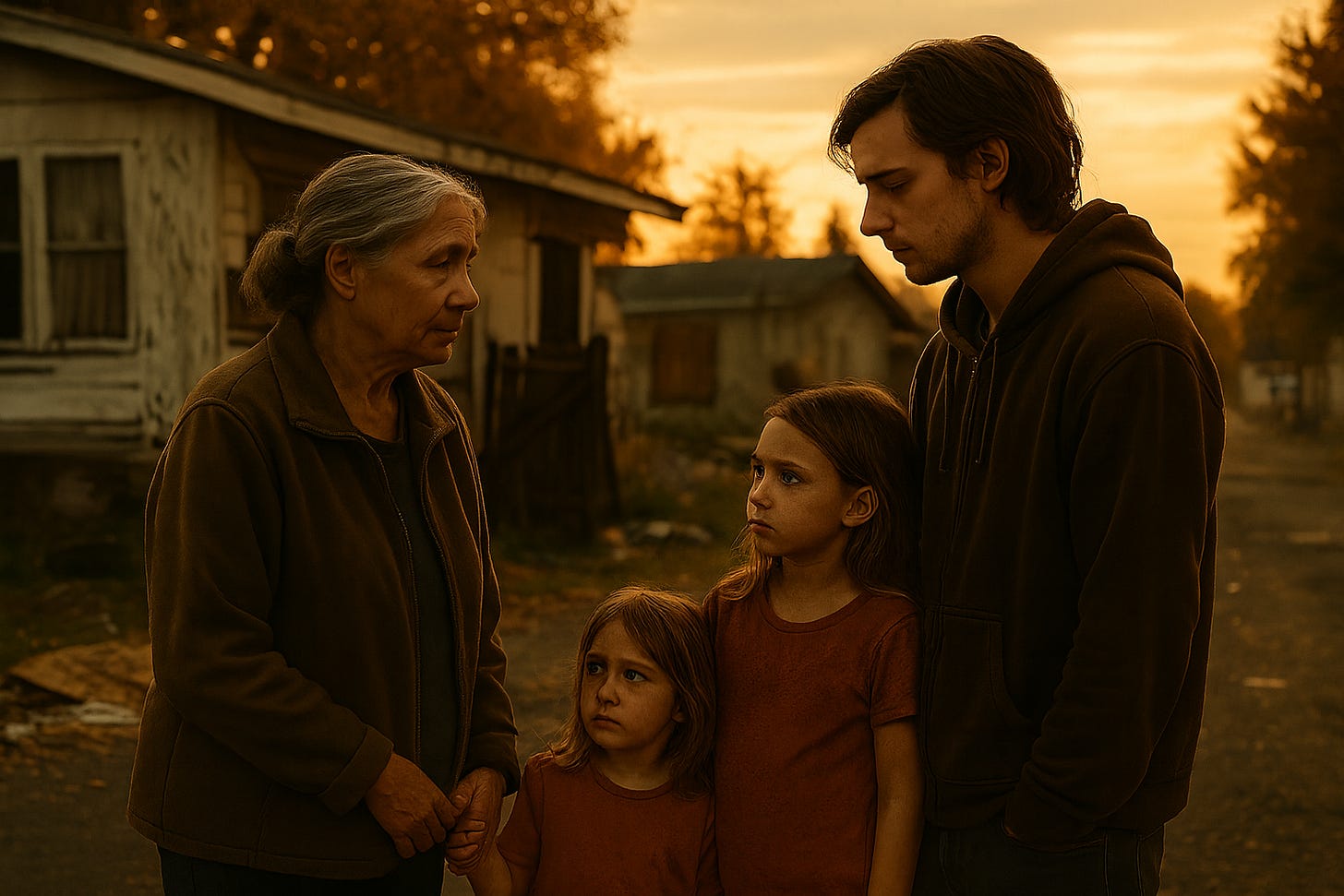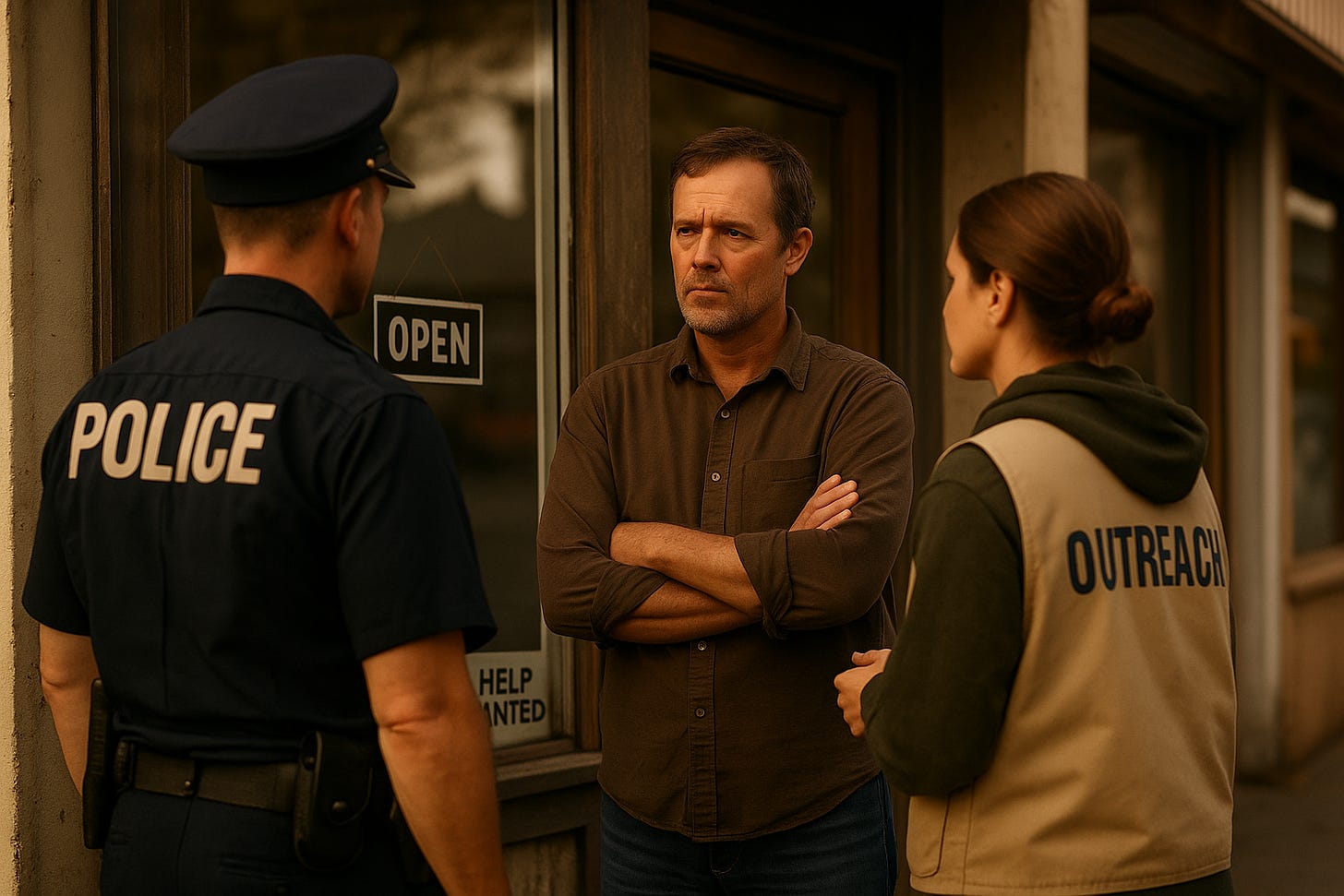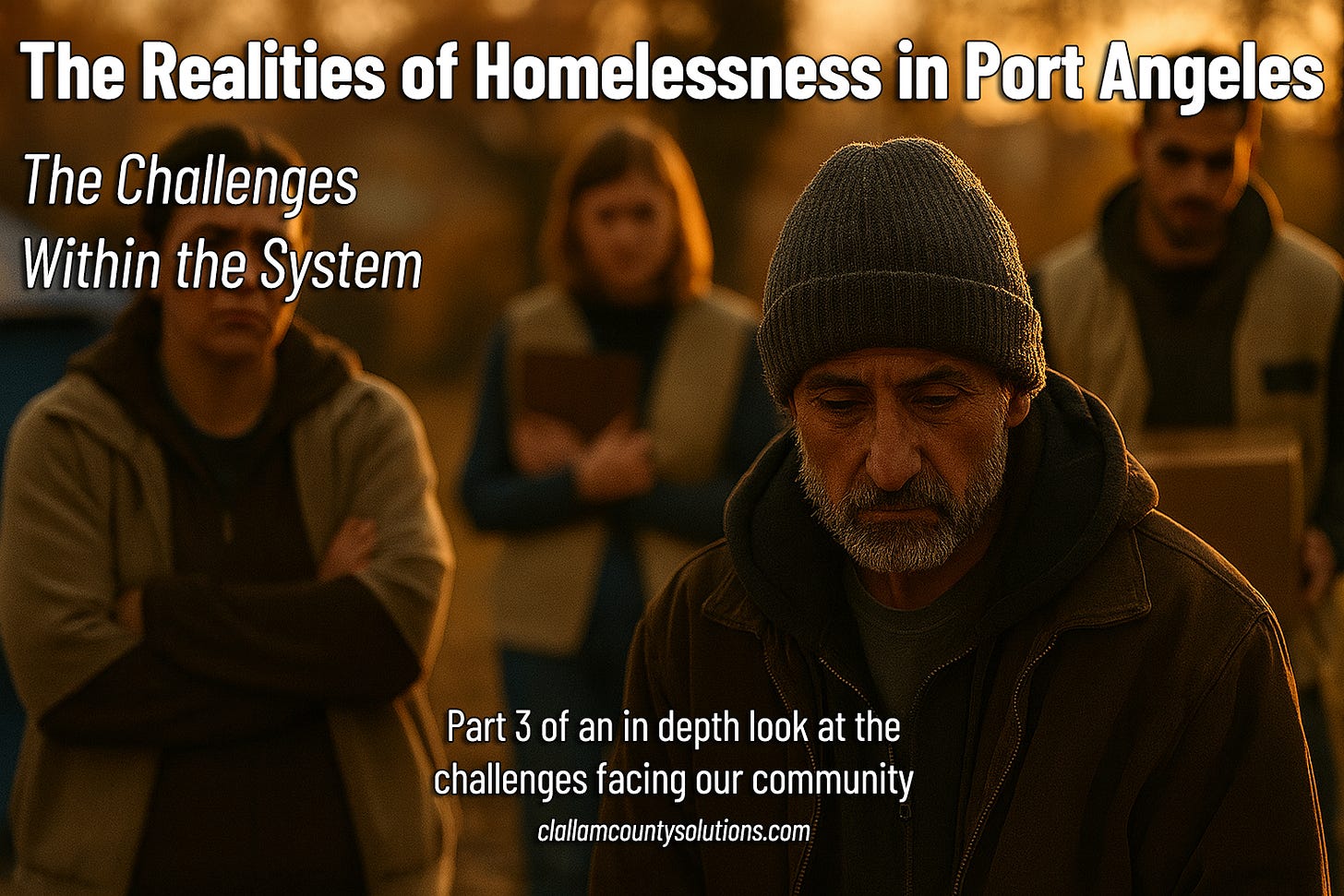The Challenges Within the System
Part Three of a Six-Part Series — the unseen barriers facing those who seek help, and the helpers working within a system stretched to its limits.
In the first part of this series, we mapped the scope of homelessness in Clallam County: not just the tents and encampments visible downtown, but also the families sleeping in cars, the seniors priced out of housing, and the young people leaving foster care without a place to land. In the second article, we turned to the helpers—leaders and organizations who make up the county’s patchwork safety net. They are the people who provide shelter beds, serve meals, offer counseling, and respond when crises spill into public spaces.
Together, those first two installments highlighted a truth that’s easy to overlook: there are no single causes and no single solutions. The spectrum of homelessness is wide, and so is the spectrum of responses.
But even the helpers themselves will tell you that the system is far from seamless. Services are stretched thin. Treatment is not always available when people are ready for it. Housing waitlists drag on for years. Rental subsidies sometimes go unused simply because no units can be found. Workforce shortages make it harder to recruit and retain skilled staff. And while many people find a path back to stability, others remain caught in cycles of addiction, trauma, and poverty that current resources cannot break.
This third article steps into that harder territory. It is not about assigning blame or painting a hopeless picture. Instead, it’s about naming the gaps that exist—gaps in treatment, housing, staffing, funding, prevention, and even public understanding. By acknowledging what isn’t working, we can better understand why progress often feels slow, and why persistence and honesty are so essential if we want real change.
Addiction, Fentanyl, and the Relentless Cycle
Ask anyone working closest to the ground what has changed most dramatically in recent years, and the answer comes quickly: fentanyl.
Joe DeScala of 4PA has watched the drug transform the landscape in just a short time. “The substance use… the fentanyl, has just completely taken over the last two years… when we first started, heroin was the main drug—we were picking up just tons and tons and tons of needles. And then all of a sudden… within a matter of months, [fentanyl] took completely over. The amount of needles that we picked up dropped off a cliff, almost like 90% reduction, and it all transferred over to the kits… used to do fentanyl. So that was a big shift.”
That shift has left deep marks on both the people experiencing homelessness and the systems trying to help them. Addiction complicates every other part of recovery. As Joe put it, “The barriers that keep [people] from taking advantage of… services—I think the addiction is probably number one. When you’re actively using, you lose track of time. Oftentimes you lose or break your phone… if you’re trying to keep yourself on a schedule and you’re wrapped up in that lifestyle, it’s pretty difficult.”
The reality, he stresses, is not that people don’t want help—it’s that fentanyl and other substances make it nearly impossible to stay connected to services or follow through on treatment plans. Even when motivation is there, the pull of addiction derails progress.

And the services themselves are limited. “For fentanyl, 30 days isn’t enough,” Sharon Maggard of Serenity House explained. Joe echoed that concern: “Thirty-day treatment is pretty quick. I’d love to see more 60 to 90-day treatments… and then if somebody can go from that into one of our facilities, like the Touchstone campus, and stay a year or so… then you’re not too far away from some sort of permanent supportive housing.”
This bottleneck—between treatment and stable housing—remains one of the system’s most critical weak points. People who genuinely want help may find a detox bed, but after 30 days they are often discharged back into shelters or the streets because there are no transitional programs to absorb them. The same dynamic plays out when people are released from hospitals, jails, or foster care without a stable place to go. Serenity House’s six-bed medical respite program, created in partnership with Olympic Peninsula Community Clinic, was designed to bridge that gap by offering short-term recovery space after hospitalization. But with fragile funding and limited capacity, it cannot keep pace with the need. Without coordinated stepping stones between crisis care and long-term stability, people frequently cycle back into homelessness, undoing the progress made in treatment or medical care.
Fentanyl may be the accelerant, but the fire often begins long before first use—rooted in family histories of trauma and instability. That’s where generational cycles come into focus.
Generational Cycles and Trauma
Not every person experiencing homelessness arrives there through a single crisis like job loss or medical debt. For a significant share of people, the roots stretch much deeper—back through families and across generations.
Sharon Maggard of Serenity House described what this looks like from the perspective of service providers: “At any of our agencies, there can be grandparents, parents, children, and even great-grandchildren in systems of care. The cycle of substance [ab]use and physical or mental trauma becomes an environmental structure in some households, and those are often our hardest cases to help.”
These families don’t just face the immediate loss of housing; they carry layers of inherited trauma that shape their daily lives. Substance use, violence, and instability may have been part of their environment for decades, leaving patterns that are hard to break. When three or four generations are connected simultaneously to shelters, treatment centers, and law enforcement, the challenges compound.
“When kids grow up watching crisis after crisis, it becomes normal. By the time they’re adults, they’ve learned how to survive chaos, not stability—and that’s the hardest thing to unlearn.”
Two groups feel this weight most acutely—those just beginning adulthood and those nearing its end. Seniors are the fastest-growing segment of the unhoused in Clallam County, rising from 53 in 2021 to 88 in 2024—a 65% increase. Once older adults lose housing, they face hurdles that shelters and hospitals were never designed to meet: mobility limitations, chronic illnesses, and the need for help with daily living. Many end up bouncing between hospital stays and the streets, with few long-term care options available, often straining an already overburdened health care system.
At the other end of the age spectrum, young people aging out of foster care or unstable family situations are among the most vulnerable to homelessness. Sharon noted how limited the options are for them in Clallam County: resources exist for adults in shelters and for men in treatment programs, but youth often fall through the cracks. Without stable housing or supportive services, they face enormous risk of falling into the same cycles of trauma and addiction that shaped their families.
Breaking these cycles—whether generational or situational—requires more than emergency shelter or short-term treatment. It calls for trauma-informed care, prevention efforts that reach families early, and consistent support across multiple systems. Yet those investments are often the hardest to secure. As leaders like Sharon and Wendy point out, most funding flows to crisis response—keeping shelters open, managing emergencies, responding when things have already gone wrong. Prevention programs that could reduce the likelihood of people entering the system in the first place—such as housing support before eviction, long-term mentoring for at-risk youth, or family stabilization services—remain chronically underfunded.

For people born into these cycles, even imagining stability can feel out of reach. And yet, providers like Serenity House continue to meet them where they are—keeping them alive, connected, and offering small steps toward change, even when the journey is measured in years rather than weeks. Those long arcs of trauma collide with short-arc systems—30-day treatment windows, grant cycles, and scarce housing. That mismatch leads directly into the next challenge: the shortage of behavioral health services and housing capacity.
Gaps in Behavioral Health and Housing
If there is one theme that comes up again and again in conversations about homelessness, it’s that behavioral health services and housing supply are not keeping pace with the need. Treatment exists, but access is fragile, inconsistent, and too often determined by geography and funding rather than urgency.
As Wendy Sisk of Peninsula Behavioral Health explained, “We have a shockingly limited number of detox [and secure withdrawal management beds] for substance use disorders in the state.” For people ready to take the first step toward recovery, that scarcity is devastating: opportunities to stabilize are missed because the beds simply don’t exist.
“We can’t always get people help when they ask for it, and that’s devastating—because that window of willingness can close so fast. When someone’s finally ready and there’s no bed, that’s a missed opportunity we might not get again.”
Geography adds another barrier. Local options are so limited that PBH staff often have to transport people long distances off the Olympic Peninsula. “We’ll get them on a ferry, take them all the way to Oak Harbor… and then sometimes when we get there, there’s not a bed available,” one staff member shared. That uncertainty can undo someone’s willingness to try. For those battling withdrawal, even a delay of a day can mean relapse before treatment begins. Staff time is consumed by these long-distance transports, pulling them away from already heavy caseloads.
The challenges are especially steep for women. In Clallam County, the only residential treatment program is for men. Women who want inpatient care must leave the community entirely. PBH staff emphasized how daunting that choice feels: leaving children, partners, and familiar networks behind to enter treatment far away. Many women ultimately forgo treatment altogether because the fear of isolation outweighs the hope of recovery. Without local options, this gender gap leaves too many women without a viable path forward.
“We have people who want to get better, but we’re asking them to start recovery hundreds of miles away from their support system. For women especially, that means leaving kids, family, and everything familiar behind. It’s hard to heal when you have to do it alone.”
Funding fragility makes the system even more precarious. While PBH ensures that no one is turned away for inability to pay, many of their programs are grant-funded. “It’s all grant funded. People aren’t turned away, but the programs are only as stable as the funding is,” a staff member admitted. That instability makes it difficult to expand or plan for long-term capacity, even as the need grows.
Housing mirrors the same challenge. Sharon Maggard noted that Serenity House often has subsidies in hand but nowhere to use them: “I have a person that has a completed subsidy in their hand… and I have 160 of those right now out on the street looking… It isn’t a program deficiency. It really is, we don’t have the rentals here.” With waitlists exceeding 2,400 households as of mid-2024, even well-funded programs can’t keep pace when the units don’t exist.

And even when someone does make it into treatment, the journey is rarely straightforward. As one PBH staffer put it, recovery often looks like a “never-ending kind of revolving door.” Small steps—accepting food, showing up for an appointment—are progress, but relapse is common. For the public, who often expect quick results, this cycle can be misunderstood as failure. In reality, it reflects how deep addiction runs and how fragile recovery can be when treatment systems are stretched thin.
The result is a system where effort and commitment are present, but capacity falls far short of demand. Clinicians and outreach staff do extraordinary work every day, but without enough detox beds, supportive housing units, or secure funding, they are asked to fight a rising tide with limited tools. And when progress is this incremental and setbacks so visible, public frustration often grows—fueling misconceptions that make the work even harder, especially when the same names appear in police logs while beds and units remain scarce.
Misconceptions and Public Frustration
Few issues draw more frustration in the community than the belief that homelessness and crime are one and the same. The reality is far more complex.
Chief Brian Smith of the Port Angeles Police Department explained it this way: “One hundred percent of [property crime] is associated with substance use disorder. We just don’t deal with property crime that isn’t connected to that. But… that doesn’t mean that all [unhoused] people are doing that… A percentage of people that we encounter are committing property crime, and we deal with that. But… it isn’t the majority, for sure.”
That distinction is crucial. The majority of unhoused people in Clallam County are not engaged in crime. They are families, seniors, and individuals struggling with housing costs, medical bills, or untreated health needs. Yet the smaller group battling severe addiction or untreated illness accounts for a disproportionate share of police calls. Those repeat encounters are what the public sees most often—and what shapes perception.
“We deal with the same individuals over and over, and people see that and think nothing’s being done. What they don’t see is the amount of outreach, diversion, and treatment attempts that happen behind the scenes. It’s not that we don’t care—it’s that the system isn’t built for quick fixes.”
The law itself compounds this cycle. As Chief Smith noted, “You can be arrested for the same misdemeanors over and over again… whatever the penalty is, you pay it, you serve your time, whatever.” For officers, this “catch and release” reality means encountering the same people again and again, without the leverage of escalating consequences or the resources to redirect them into effective treatment.
From the outside, this can look like willful refusal to change. From the inside, service providers and police see how addiction, mental illness, and systemic gaps keep people stuck. The frustration is real—felt by business owners, residents, officers, and even shelter staff who see progress undone by relapse or by systems stretched too thin. But so is the danger of oversimplification.

Misconceptions also extend to the very organizations trying to help. Joe DeScala has fielded accusations that 4PA discards the belongings of unhoused people during cleanup efforts. He rejects that narrative, pointing out that his group works openly and visibly in the community: “We’ve been accused of being an extremist mob… but I always say, if we were out committing crimes, why would we be wearing bright orange vests with 4PA written on the back, or driving trucks with lights flashing? We’ve never hidden what we do.”
Serenity House faces its own share of skepticism. Some critics accuse shelters of “enabling” homelessness by offering meals and beds without requiring sobriety or immediate change. Sharon Maggard pushes back against that view. For her, the question is not whether providing shelter solves the crisis, but whether failing to provide it allows people to survive at all. As she often reminds skeptics, without emergency shelter, people die on the streets.
These misunderstandings—both of people experiencing homelessness and of the providers who serve them—make a difficult job even harder. They feed public cynicism, weaken trust, and fuel the sense that nothing is working. But as the interviews make clear, the reality is neither as simple nor as hopeless as critics often claim.
Recognizing that complexity matters. It allows space for nuance: to acknowledge that yes, there are people who commit crimes or relapse into addiction, but also that most want stability and simply can’t reach it with the tools available. And it allows room to appreciate that helpers are not enabling failure but preventing worse outcomes in a strained system.
Still, these pressures don’t stop at public perception. They land heavily on the people inside the system itself—stretching staff and volunteers close to breaking.
The Human Cost — and the Cost to Helpers
Behind the statistics are not only people experiencing homelessness, but also the staff and volunteers working daily to respond. Their compassion is the backbone of the system, but it comes with a cost.
At Serenity House, Sharon Maggard has seen her housing staff stretched thin by the imbalance between a tenant’s ability to adapt to the structure of stable living and the realities of permanent supportive housing. Many residents come in with disabilities, substance use disorders, or other challenges that make it difficult to adjust to shared spaces and behavioral expectations. “We support thousands of people every year through rent and eviction prevention, and yet we only have 51 permanent supportive housing apartments—and those don’t turn over unless somebody dies, goes to jail, or we’re forced to evict,” she said. “The waitlist is currently 144 households.”
That imbalance goes beyond numbers—it’s about maintaining safety and structure. “Our tenants agree to follow simple rules like no smoking or using drugs indoors,” Sharon explained. “But when someone is struggling with addiction or mental health issues, that structure can be hard to maintain. Once housed, they have the right to refuse services, which leaves our staff constantly trying to keep everyone safe while calling on partners to help manage behavioral health or substance use problems.”
The pressure on staff is not just logistical—it is emotional. “When our limited resources can’t help us resolve a behavioral problem, we sometimes have to evict people, and that’s heartbreaking,” Sharon said. “Normally this leads to a full twenty to forty-thousand-dollar cost to evict and repair our apartments.”

In 2024, Serenity House’s Port Angeles shelter alone provided 42,679 bed nights and served more than 50,000 meals to 661 individuals. Each of those nights and meals represents a person kept safe indoors, able to receive treatment, and connected with referrals to partner agencies for ongoing support. Those same numbers also highlight the relentless pace placed on staff. Demand is steady and overwhelming, with little relief in sight.
The strain is similar at Peninsula Behavioral Health. Wendy Sisk acknowledged the frustration her staff feel when demand for services keeps growing, even as physical space and staffing remain limited. “We’re running out of office space… my staff are full to the max,” she said. But she emphasized that PBH does not have a waitlist for therapy or treatment—contrary to a persistent public rumor. “That’s something we’re really working hard to dispel,” Wendy explained. “Anyone who needs help can begin services quickly, because we intentionally keep our doors open for walk-in access.”
While PBH ensures timely entry into care, ongoing workforce shortages still mean heavy caseloads and emotional strain for clinicians. Supervisors describe the difficulty of hiring and retaining staff with the right mix of skill and resilience: “If we hire the wrong staff, it can actually do harm… it’s hard to find people with the skills and the compassion who can stay in it.” The result is a cycle of burnout and turnover, with those who remain carrying more weight than ever.
“It’s hard to keep asking people to give their whole hearts to this work when they go home at night feeling like they didn’t do enough. The truth is—they’re doing everything they can, but the need just keeps growing.”
The problem isn’t just burnout—it’s retention. Experienced staff who know how to navigate complex systems, build trust with clients, and de-escalate tense situations are often the ones most at risk of leaving. When they burn out, agencies don’t just lose manpower; they lose hard-earned expertise that cannot easily be replaced. Each departure leaves new hires to start from scratch, with clients experiencing the disruption most directly. And when trust is the currency of change, the loss of a familiar case manager can set a client back months.
Even the logistics wear people down. PBH staff often transport clients hours away for detox or treatment because no local options exist. As one employee shared, “We’ll get them on a ferry, take them all the way to Oak Harbor… but that means I lose a staff member for the next day, because it’s exhausting. It’s a huge ask, even though people do it because they care.”
Law enforcement feels a parallel strain. The Port Angeles Police Department is operating with far fewer officers than its workload demands. Calls related to substance use, repeat offenders, and public safety pile on top of everyday policing duties, pulling officers in multiple directions at once. For Chief Smith, the shortage means responding to the most urgent needs often comes at the expense of proactive community policing. Instead of building trust through consistent presence, officers are stuck in a cycle of crisis response, which deepens both community frustration and officer fatigue.

This is the quieter cost of the crisis: the toll on those trying to hold the system together. Burnout, compassion fatigue, and retention struggles are not abstract terms—they’re lived realities for the case managers, shelter staff, clinicians, and officers who face the cycle day after day. And yet, despite exhaustion and limited resources, they keep showing up. Their persistence may not solve homelessness outright, but without it, the fragile safety net holding the community together would collapse.
These human costs underline a larger truth: the challenges of homelessness in Clallam County are not only borne by those living without shelter, but also by the helpers working to respond. And understanding that reality sets the stage for the final question of this article—why naming these challenges, rather than avoiding them, is so essential.
Conclusion: Why Facing Challenges Matters
Looking closely at Clallam County’s homelessness response reveals a sobering truth: even the most dedicated helpers are working within systems that are stretched thin and often underpowered. Addiction—especially fentanyl—has transformed the landscape, creating barriers that short treatment windows and scarce detox beds cannot fully address. Generational cycles of trauma keep entire families tied to shelters, law enforcement, and behavioral health. Prevention programs that might break those cycles early are underfunded, leaving the system focused on crisis response rather than long-term change.
Some groups carry especially heavy burdens. Seniors are the fastest-growing segment of the unhoused, rising from 53 in 2021 to 88 in 2024—a 65% increase. Once older adults lose housing, their health and mobility needs often exceed what shelters can provide, leaving them caught between hospital stays and the streets. Youth face the opposite problem: aging out of foster care or unstable homes with almost no local programs designed for their unique circumstances. Both groups—at the bookends of life—highlight the urgency of creating housing and services that fit their specific needs.
Housing shortages add another layer, with subsidies sitting unused because there are no available units. Women face unique barriers to treatment, often forced to leave the community entirely to find residential care. And staff shortages ripple through every corner of the system, with burnout and turnover eroding the stability of the very organizations the community depends on.
These realities fuel public frustration and misunderstandings. Visible repeat offenders reinforce the perception that nothing is changing, while the quieter majority who want stability are often overlooked. Misconceptions extend to the service providers themselves, with groups like Serenity House or 4PA sometimes criticized unfairly for their approaches. The truth is more complicated: helpers are not enabling failure but preventing worse outcomes in a system with too few resources.
“It’s easy to feel like we’re losing ground because the need is so visible. But every time someone gets housed, gets sober, gets through one more night safely—that’s progress. It just doesn’t always look like it from the outside.”
Naming these challenges is not pessimism—it is honesty. Honesty clears the way for persistence and solutions. Every meal served, every therapy appointment kept, every shelter bed opened matters, even if the broader system feels overwhelming.
In the next installment, we’ll turn directly to the intersection of homelessness and public safety. We’ll hear more from Chief Brian Smith and look closely at crime statistics from the Port Angeles Police Department. We’ll explore both the visible impacts—encampments, property crimes, repeat offenders—and the less visible reality that most people experiencing homelessness are not engaged in crime at all. Balancing safety and compassion is one of the greatest challenges our community faces, and in the fourth installment we’ll examine why both must be pursued together.
Active dialogue and engagement with our readers is crucial. Writers on this platform are encouraged—and expected—to revisit their articles regularly, responding thoughtfully to readers’ questions and concerns.
We want conversations, not shouting matches. Therefore, comments will be reviewed regularly and are expected to adhere to these foundational guidelines:
Stay on Topic: Comments must relate directly to the article.
Respectfulness: Every comment should demonstrate respect toward authors, website management, and fellow commenters. Bullying, name-calling, or disrespectful behaviors will not be tolerated.
Constructive Dialogue: Political grandstanding is unwelcome here. While some discussions naturally involve political elements, the goal is to enhance understanding, clarify perspectives, and contribute constructively.
No Personal Attacks: As Theodore Roosevelt wisely said, it’s the person who is “actually in the arena” who deserves our respect. Criticism is welcome, but personal attacks are not.
Transparency: Any new guidelines needed as this platform evolves will prioritize civility, decency, and productive dialogue.




Danny, some random stream of conscious thoughts...
1.) We all understand the nuance required to understand the complexity of homelessness in COPA, ranging from seniors to young adults leaving foster care. We all understand that not everyone who is homeless is a drug addict, and that deserves recognition.
HOWEVER, it’s also clear that addiction, especially to fentanyl, is central to much of the crisis. Even Chief Smith acknowledges that "100% of property crime" is linked to substance use. Wow! Mind blown. That is a stunning admission, so it bothered me when your article immediately softened it by stressing "not all unhoused are criminals". Of course not. We know that, but it misses the point. If nearly all property crime stems from drug use, then the logical conclusion is that drug addiction, and perhaps not housing, is the most urgent public-safety issue. Yet the article pivots right back to a “public misunderstanding” and “the need for compassion.”
This is where I become more critical. I have been on a ride-along with our already overworked police officers and have seen and heard first hand how much time is spent on repeat offenders and drug users. I could go on and on about society's loss of a moral compass, but I digress. My point is that your article touches on that reality, but quickly pivots to systemic gaps and underfunded services, rather than confronting how drug use drives much of the public disorder residents and businesses "experience" (or rather, are forced to accept?).
2.) I agree that compassion is essential. I am all for hand ups, not hand outs. My point is that we can not absolve personal responsibility. Without accountability it becomes enabling. Many housing first programs across the country, from Seattle and San Francisco to Portland and Los Angeles, have poured BILLIONS into low-barrier housing and free services with few requirements for sobriety or participation in treatment. The results have been beyond disappointing: overdoses continue and the number of chronically homeless individuals in those cities has barely improved despite massive spending. In San Francisco, I read somewhere that more than half of all permanent supportive housing tenants relapse or continue using, and I have seen first hand the open-air drug markets that operate just blocks away from taxpayer-funded housing projects.
3.) Given I am a data nerd focused on quantifiable outcomes, here is the crux of it all. Many of these programs often measure success by the number of units built or the number of people temporarily housed, not by how many actually recover or maintain stability. By providing unconditional shelter and resources, the system can unintentionally remove the incentives needed for change. Meanwhile, we never see improvement! We lose faith in the effectiveness of the police and the government. We already know we can't trust the crime stats because so much is unaddressed, unreported, and unprosecuted. Encampments cycle back as fast as they’re cleared. The futility of it all is why Joe and 4PA impress me with their doggedness. He is a modern society's version of Sisyphus.
4.) I started my thoughts arguing that the debate is nuanced. There definitely is not one service or solution that fits every situation. At least for me, it "mostly" feels more like a cycle of management, not resolution. I worry if we continue to fund compassion over requirement for real transformation, we will keep seeing the same cycle of addiction, crime, and despair, no matter how much empathy or money we pour into the system.